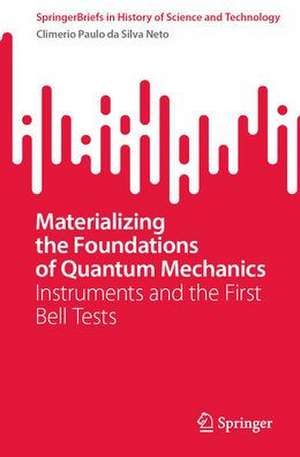Materializing the Foundations of Quantum Mechanics: Instruments and the First Bell Tests: SpringerBriefs in History of Science and Technology
Autor Climério Paulo da Silva Netoen Limba Engleză Paperback – 25 mai 2023
Din seria SpringerBriefs in History of Science and Technology
- 8%
 Preț: 387.78 lei
Preț: 387.78 lei -
 Preț: 377.18 lei
Preț: 377.18 lei -
 Preț: 443.75 lei
Preț: 443.75 lei -
 Preț: 377.35 lei
Preț: 377.35 lei -
 Preț: 377.35 lei
Preț: 377.35 lei -
 Preț: 378.34 lei
Preț: 378.34 lei -
 Preț: 379.09 lei
Preț: 379.09 lei -
 Preț: 378.54 lei
Preț: 378.54 lei -
 Preț: 378.34 lei
Preț: 378.34 lei -
 Preț: 377.73 lei
Preț: 377.73 lei -
 Preț: 448.21 lei
Preț: 448.21 lei -
 Preț: 377.35 lei
Preț: 377.35 lei -
 Preț: 408.66 lei
Preț: 408.66 lei -
 Preț: 478.33 lei
Preț: 478.33 lei - 20%
 Preț: 296.67 lei
Preț: 296.67 lei -
 Preț: 411.16 lei
Preț: 411.16 lei -
 Preț: 374.30 lei
Preț: 374.30 lei -
 Preț: 379.09 lei
Preț: 379.09 lei -
 Preț: 489.30 lei
Preț: 489.30 lei -
 Preț: 378.54 lei
Preț: 378.54 lei -
 Preț: 476.57 lei
Preț: 476.57 lei -
 Preț: 378.92 lei
Preț: 378.92 lei - 15%
 Preț: 461.87 lei
Preț: 461.87 lei -
 Preț: 442.83 lei
Preț: 442.83 lei -
 Preț: 446.08 lei
Preț: 446.08 lei -
 Preț: 379.48 lei
Preț: 379.48 lei -
 Preț: 379.86 lei
Preț: 379.86 lei -
 Preț: 344.53 lei
Preț: 344.53 lei -
 Preț: 378.92 lei
Preț: 378.92 lei -
 Preț: 347.41 lei
Preț: 347.41 lei -
 Preț: 324.70 lei
Preț: 324.70 lei -
 Preț: 377.35 lei
Preț: 377.35 lei -
 Preț: 444.35 lei
Preț: 444.35 lei
Preț: 376.04 lei
Nou
Puncte Express: 564
Preț estimativ în valută:
71.96€ • 78.14$ • 60.45£
71.96€ • 78.14$ • 60.45£
Carte tipărită la comandă
Livrare economică 22 aprilie-06 mai
Preluare comenzi: 021 569.72.76
Specificații
ISBN-13: 9783031297960
ISBN-10: 3031297962
Pagini: 73
Ilustrații: IX, 73 p. 16 illus., 2 illus. in color.
Dimensiuni: 155 x 235 mm
Greutate: 0.13 kg
Ediția:1st ed. 2023
Editura: Springer Nature Switzerland
Colecția Springer
Seria SpringerBriefs in History of Science and Technology
Locul publicării:Cham, Switzerland
ISBN-10: 3031297962
Pagini: 73
Ilustrații: IX, 73 p. 16 illus., 2 illus. in color.
Dimensiuni: 155 x 235 mm
Greutate: 0.13 kg
Ediția:1st ed. 2023
Editura: Springer Nature Switzerland
Colecția Springer
Seria SpringerBriefs in History of Science and Technology
Locul publicării:Cham, Switzerland
Cuprins
Introduction.- Bell's Inequality Experiments.- Sources of Entangled Photons.- Analyzers.- Detection Sets.- Twinning the Threads.- Conclusions.
Notă biografică
Climério Silva Neto is an assistant professor of physics and history of science at the Federal University of Bahia (UFBA), Brazil. He holds a bachelor's degree in physics (2009) and master’s (2011) and doctoral (2015) degrees in history and philosophy of science and science teaching from UFBA. His Ph.D. dissertation on the making of the Soviet laser physics won the prize for best dissertation in history of science awarded by the Brazilian Society of History of Science and Technology. His training/research experience includes one academic year as a visiting graduate student at the University of British Columbia and shorter research stays at the American Institute of Physics, the Archives of the Russian Academy of Sciences, and the Centre for History of Sciences of the Royal Swedish Academy of Sciences. His current research focuses on the history of physics in the 20th century from the perspective of instrumentation and transnational collaboration/competition. The present manuscript stemmed from a handbook chapter for The Oxford Handbook of the History of Quantum Interpretations (March 2022) on the instrumentation of experiments in the foundations of quantum mechanics.
Textul de pe ultima copertă
This book offers a history of the instrumentation used to materialize the early thought experiments devised in the Einstein-Bohr disputes over the foundations of quantum mechanics. It shows how the second world war and cold war fostered the development of materials, instruments, and systems that made it possible to create, manipulate, and detect single quantum systems, thus creating the material conditions for experiments in foundations of quantum mechanics and for a broad spectrum of experimental inquiries on the structure and properties of matter which underlay the creation of new research fields such as quantum optics, quantum information, and atomic, molecular, and optical physics. Discussing research and development performed in diverse contexts, this book reveals how physicists carried instruments, and the knowledge they embodied, through disciplinary and geographic frontiers to probe entanglement, a most intriguing feature of the quantum world.
Caracteristici
Integrates developments in the Soviet Union using primary and secondary sources in Russian The first book to cover the development of the instrumentation that allowed to perform the first Bell tests Offers a history of the instrumentation used to materialize early thought experiments
